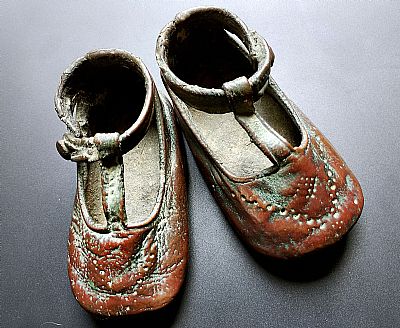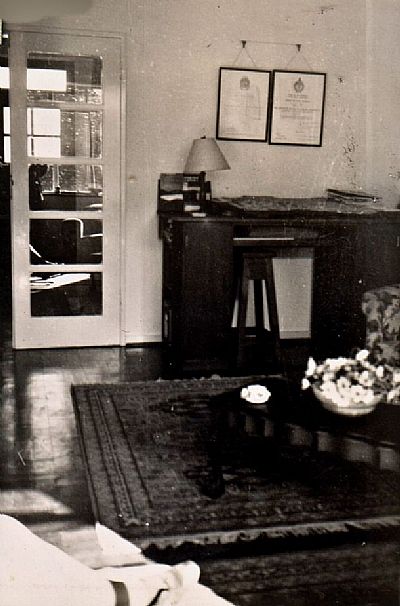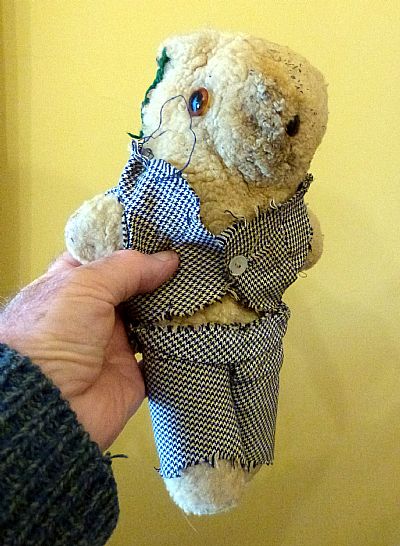GROWING UP : THE EARLY YEARS
I was born at an early age in a nursing home in Germiston. My parents had a rented house in Johannesburg. My father had an architectural job there, having trained at WITS University. They had met through the Christian Science Church.
At 2 months old I took my first flight – to East London. Our first home was a flat in the Quigney, up from the Orient Beach, where I was evidently taken for walks in the pram. (West of Fitzpatrick Road).

My first home in East London. Buckingham Court in the Quigney. This was probably our own moving day. Steer and Co was and still is the main furniture removal company there.

Oddly, I still have my first shoes. These were bronzed and sat on display for years.
In time we moved to 10 Tate Road in Baysville, a modest house, fairly new at the time. I remember having an arched fireplace, glass dual swing doors in the entrance, a metal front gate and a spindly hedge.

And my second home. 10 Tait Road in Baysville. In the foreground is the front garden of 12 Tait Road where we moved when my maternal grandparents moved from their flat in Belgravia to be closer to us, my grandfather requiring increasingly frequent care.

This is the lounge of our first house. It doubled as a study for my father. His heavy desk, which he had his whole career, stands at the far wall, his degree certificated hanging above it. The double swing glazed doors led to the dining room. The kitchen was to the left. Strange how after all these years I can still remember much of this quite clearly.
At this time I had a nanny, a small black woman called “Tiny”. I have vague memories of her hoisting me into a blanket and onto her back. She appears in a photo with us seeing Nana and Da off onboard a ship.

This is an extract from a larger photo (shown under maternal grandparents) . Tiny accompanied us onto this ship to bade them farewell. That is me between her and my mother. Note her crisp uniform.
Our maternal grandparents, Nana and Da, lived in a flat in Belgravia next to the church that my father had designed. I have a memory of being delighted how big the fresh peas were and trying to show them by putting them into the phone. As Da aged and required more attention, they moved into this house and we moved into the double storey house next door, number 12.
I remember when my brother Peter was born. On being shown this baby through the maternity home corridor window, I changed my mind about having a little brother. That bundle was nothing like what I had been promised. And for some time thought we had bought him there. I hope he forgives me for this. I think it is a common perception of older siblings that aren't yet old enough to quite understand. Those that are born next simply accept the status quo.
Our first dog was a dachshund called Roly Poly. In spite of his very short legs he could clear the fence. I don't know what happened to him. In time we had a smelly fox terrier called Judy that a friend of our mother's gave to us when she got remarried. We had a few cats, but I think some of these were temporary and belonged to our Watson cousins while they moved house. (Graham and Elise lived nearby for some years in Stirling with their 3 girls in a house our father designed for them before moving to Durban, later Westville).
Nana used to sometimes take me to the market that was situated behind the council building in lower Oxford, East London, and stretching across to Buffalo Street. Rows of concrete tabled with signs above each gap or aisle designating whether whites or “natives” could go into them. Low concrete tables with produce laid out in bulk –wooden boxes or bags. Bidding was from one end with some bias
towards one side, but then buying in bulk was mainly by the hotels and the few restaurants. The “German Market” was much the same and at one end. The difference was that you could simply walk up and buy from the mainly German farmers. (Remember that German identity was still strong from amongst the families of the many who settled in the region as British German Legionnaires in the 1850's). Nana would buy fruit or tomatoes in wooden boxes or other vegetables in bunches and
then contact her friends to share the bargains.
Black folk used to sell on the streets. Sensible packaging and bagging came much later and you can still see such exposed produce around the city streets. There was a fish section too; fish having been brought up from the harbour. I think this was mainly small boat fishermen. It was common to see coloured fishermen along the road from the
harbour selling a variety of fish to stopping motorists. There was a fair sized Johnson and Johnson fleet still then, but I think they sold off their catch independently.
Produce such as peas bought at the market or even shops would be hand shelled and it was common to see black women, maids, in chatting groups on a pavement lawn sorting them for different
households.
I don't remember quite when supermarkets started in EL. The first one we were taken to was very small, a mini-mart by today's standards, and run by the Lamont family in Currie Street in the Quigney. There was one big difference to what we had been used to – you could pick your own items before taking them to a till. But I still remember the staff wearing brown coats (such as you see in period tv sitcoms today).
We played with our Dinky Toys in the compost pile behind the maid's room. A store between that and the garage had our father's army helmet and some other items, a few of which we still have. (I have the trunk which I used to cart stuff off to university, although since turned blue. And the army blanket which I used for scout camps and was riddled with badges, but I still have it).

My teddy bear got ravaged by our daschund, Roly Poly. My mother did some successful surgery and it remained loved. I made it some pyjamas, well actually my mother helped (extensively). It no longer sees daylight very often any more, but I still have it.
Preschool for me was a bit of a trial as I was very shy, but I have nice memories of a toy block structure that you could role marbles down and a visit next door to see strange little fledgling budgies. Then it was off to Stirling Primary Schools (which I discuss here : GROWING UP : THE PRIMARY SCHOOL YEARS). I soon found that the boy who lived down the road was in the same class and we became good friends. Robert McDougall and his sister Lorraine (Lolly). (He contacted me out of the blue some years ago having moved to Wales. He seemed very changed and I didn't maintain contact).
Something that remains with me though to this day, is seeing the police arrest the maid of the house that backed ours, for stealing from the family. On being asked why she did so, she said it was because they had much and were privileged but she had almost nothing and was destined to remain so unless she did something like that.
The bushveld grass would catch fire occasionally, from intent or accident. The fire brigade would usually pitch up as the residential area was so close. I have memories of going down the road on P's tricycle with watering cans on the back to help the fire brigade put the fires. When I was little I thought that Fire Men started the fires. That bushveld was to be developed for housing and two schools, initially along McJannet Drive and the adjoining road (before the freeway was pushed through). The schools were Grens Hoerskool and the Baysville Technical High School. Scaffolding then was steel with roughly fixed down planks. Wheel barrows, so rare in the UK, are still very common in SA so long ramps would lead up to the lower floors. We used to dare each other to ride our bikes up and down them. Fortunately our nerves got the better of us or we could have met with serious accidents. Security was lax. We used to take the off-cuts of reinforcing and skim them along the road in the warm evenings to create sparks.
I was impressed by traffic controllers. This was an era when they would stand with white gloves on a round box at the bottom of Oxford Street to control the traffic. I used to stand in the middle of our own road, Tait Road, with my hands up to control the traffic too.
I don't remember Health & Safety in South Africa. While at Stirling Primary School we spent some of our physical education levelling the new sportsfields. Large trucks would arrive to dump piles of earth. We still little people would be given some garden implements and told to level it over the edge. One day my allotted tool was a large garden fork. As I thrust it down to break up the large sods of earth it went through between the straps of my plastic sandals right into my foot.
One day we came across a large pile of white ash from bush and rubbish clearing at the Grens Skool building site. As a joke I jumped into it expecting a waft of fine ash. Instead I found my sandal clad
feet deep in red hot coals below. My extremely quick reaction saved further injury, but I had learnt a hard lesson and had a sort of freckled ankle to mark the spot for years.
Playing in the street whether it be a warm summer evening or flooded gutters was common for most kids. This seems to have already been almost unknown in the UK; or was it in those years?. The climates are very different. While much of the change can be put down to increased awareness and fears of safety by parents, changing social expectations and indoor digital games and TV in the UK, it has also changed dramatically in SA as safety concerns have risen exponentially. There may be many reasons, but the one that is evident from my above examples is that with the demise of apartheid came much less hesitation by those with ill intent to harm absolutely anyone. Being a
white kid in the '50s almost protected you.
Even at that stage and young age we would usually walk the several miles to school on our own. If you are reading this in South Africa or in the UK you will have very different reactions to this. We were still very young (I was 10 when we left Tait Road, Peter 8), but sometimes we would be allowed to go into the city centre on our own by bus. We were given pocket money which was usually spent at OK Bazaars in cheap toys. This simple sounding activity illustrates too the idyll of the apartheid years - if you were a white child. Public transport and wandering around the town centre were considered safe for you.
Some memories may have warped a bit with childhood imagination, but I have this clear image of sitting on the curved mudguard of Da's car, my legs and arms wrapped around the bulbous light as he drove up the street. I am sure that I did sit like that. However did he ever drive up the road with us like that? I don't know what make of car it was, but this one in the picture is a possibility and shows how this was
possible. New cars were looking very different in the '50s, but '40s cars were still very common.
 but
but
His car was something like this one. We certainly sat on the mudguards with our legs around the bulbous lights, but are my memories of actually being driven around the block imaginations developed over the years?
This is a 1940s Ford Anglia just as an example – google image.
Da had had lost a hand in an electrical accident a long time previously and wore a heavy prosthetic leather glove hand when driving and drove only rarely.
A bad memory that I still have is also tied to Christian Science. It traumatised me for years. I would lie awake some evenings with asthma screaming and crying. My father would scream from the next room to shut up. We also learnt the piano at the time, but I was never allowed to rest my back against the back of the chair (we usually used then round stool that screwed up and down). (My asthma flared badly during my navy training and only was reasonably resolved in my late '50s by the Scottish NHS). I still suffer from terrible back pains. But Christian Science, while on the one hand appearing to protect me, as in the bush, was also denying me medical help for real complaints.
[In retrospect the treatments for these childhood ailments were little developed in the'50s]. We may have had dentistry, but we never went to doctors and never had the inoculations that other kids had against the medical terrors of the day. I remember having measles and seeing kids at school with the effects on their limbs such as Thalidomide, but only ever heard that term much later. Our family simply did not talk of diseases. I had serious asthma, but never treatment. And I only got to know the word “asthma” because a boy (called “Puffy”) at scouts had it. In Christian Science talk, at least to children, disease is simply an error. And as an error it is just a wrong thought. To me - That thought was inside my mind. I had something wrong with my mind. And something wrong with my body. I was imperfect. It was all MY fault. A subconscious sense of guilt lingered most of my life peaking during those difficult years of self doubt in late teens and into my twenties.

